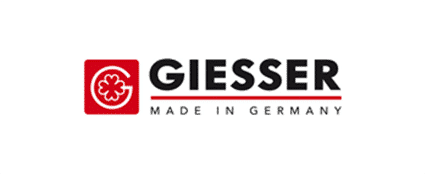
As one of the world’s leading manufacturers of quality knives and accessories for professional users, Johannes Giesser Messerfabrik GmbH manufactures more than 8,000 professional knives every day at its headquarters in Winnenden, Baden-Württemberg. Around 2,500 forged or stamped knives for the catering and food processing industries are part of the product range of this traditional company. Giesser has been producing knives and cutlery by hand since 1776.
Today, the manufacturer of hand knives relies not only on craftsmanship but also on computer-aided work to keep pace with market developments. The latest IT coup of the knife factory: real-time visualization of production processes and data on monitors in the production hall and in the offices – so that all employees can see at a glance whether everything is running smoothly or where the final touch is still missing at any time.
“Every week we receive about 20 production orders. These result in requirements for sub-articles, which are then produced at various stations. The heart of the system is the blade production, which takes place in eight different work steps. Up to now, we used to map the order management via printed out plug-in cards, which the employees of the various groups had to obtain according to the work process,”
explains Björn Mutschler, head of the injection moulding department at Johannes Giesser Messerfabrik GmbH.
“However, this paper-based option has its pitfalls: paper printouts are not only expensive, but they contain rigid information that only corresponds to the facts at the time of printing. If an order is given a higher priority at short notice or the quantity required has changed, it was necessary to make sure that the circulating slips of paper were captured, reprinted and re-placed as quickly as possible. Errors in delivery dates or production quantities are virtually pre-programmed. We wanted to change that with the digital visualization of the orders.”
Since the ERP system CimMETAL used so far did not allow for the visualization of the data, a specific IT solution was needed to provide the desired transparency.
Giesser has now decided to go with Peakboard. The installation-free all-in-one solution offers all necessary hardware and software components for the aggregation of data from various source systems and their visualization in real time – packed in a smartphone small aluminum box. The management was initially sceptical.
“At first you only see a miniature computer and wonder why you should spend money on it when there are small single-board computers on every corner for less than a hundred euros,” Mutschler recalls. “When the small computer was finally able to show what it is capable of in the free trial from Peakboard, the okay came immediately.”
“First, we visualized a complete overview of our production orders with all work steps on one dashboard,” Mutschler explains. “The basic idea was that we wanted to show the reports for each work step: For every production step, we feed back into the ERP system. When the punching process is completed, the employee at the punching machine reports back the quantity produced. This quantity is the starting point for the next operation and tells whether a smaller quantity needs to be completed or whether the quantity is sufficient. In the past we have always had major differences here. Because the number that was reported back was only in the ERP system, i.e. it virtually disappeared in a black box, the employee had no insight into whether he had entered his number correctly. With Peakboard he now has this transparency and we can be sure that the numbers are correct.
In the meantime, around 60 employees in production and two employees in the master office use a total of five different Peakboard Boxes. The shipping department uses a backorder dashboard to find out which backorders are available for which calendar weeks. Detailed information on which customer orders are affected is available at the click of a mouse. The Peakboard Box in the stamping shop visualizes key figures for the work steps such as stamping and hardening. Another Peakboard Box is located in the grinding and polishing shop.
“Every dashboard has several functions,” adds Mutschler. “By using function keys on a keyboard, we can call up several screens. For example, we have stored the shift and vacation schedules for the foreman’s office as a PDF document on the Peakboard Box with the general overview. Or: If a machine fails, the employees can manually set the dashboard to red, and at the same time an e-mail is sent to the employee responsible for the respective machine.”
The response of the employees was very positive. The production employees found it appreciative to be integrated into the process through Peakboard instead of working isolated from information about the current production status.
“Of course, with the newly gained transparency there is also more pressure, because now you can see if you are not meeting your target values” says Mutschler. “However, the employees perceive this pressure mainly in a positive light – as an incentive to achieve their production targets and to see how well they are performing”.
The main benefit of using Peakboard lies in the newly gained transparency across all production steps. Thus, production efficiency has been improved through faster and more precise processes. The elimination of paper-based order management and shift planning has also significantly reduced paper consumption.
Further dashboards with Peakboard or the perfection of existing dashboards are already in planning. Giesser is currently working on the implementation of a management dashboard that maps the visualization of business data such as cash flow without first having to request reports from the accounting department.